The American Way, Part 2: Coincidence – Double Bay, NSW
Goldfinger said, “Mr Bond, they have a saying in Chicago: ‘Once is happenstance, twice is coincidence, the third time it’s enemy action.’”
– Ian Fleming, Goldfinger (1959)
One of Australia’s greatest sins is envy. In the early years our aspirations cast us firmly in the role of Little England, and ever since World War II we’ve aspired to be Little America. Look around: we’re doing a pretty good job.
But for a couple of decades there we achieved what appeared to be a national identity, entirely based on the most valuable export of all – celebrity. Movies, personalities and music we could call our own. Our Kylie. Our Hoges. Our Mark “Jacko” Jackson.
Up until the mid 1960s, it seems as if Australia’s music scene simply seemed to coincide with what was going on overseas. Johnny O’Keefe wasn’t overly concerned with copying his American contemporaries (for creative reasons, anyway); his association with US-born promoter Lee Gordon barely qualified as even a mere facsimile of an Elvis-and-the-Colonel style relationship.
Largely forgotten by the time of his death in 1963 after years of declining fortunes, Gordon’s contributions to Australian pop culture remain relevant. These include opening Sydney’s first striptease club and drive-in restaurant (sadly, two separate establishments), and translating into local parlance the blueprint for rock’n’roll success.
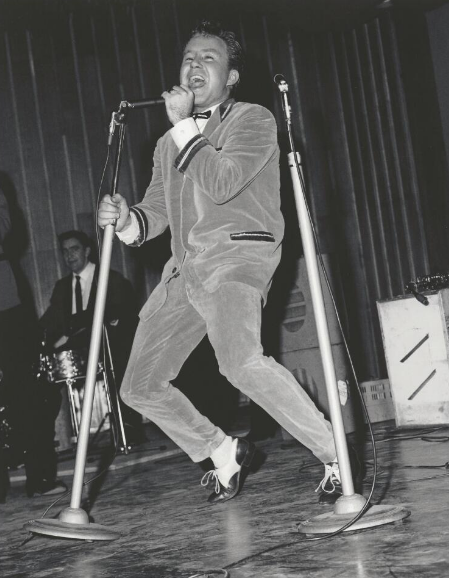
Johnny O’Keefe gets wild, late 1950s. Image courtesy NLA
O’Keefe, Australia’s first “homegrown” rock star, may seem tame by today’s standards, but in 1958 he was a revelation. “Wild One”, his signature tune, persists today, best known to stoners and the unemployed as part of the opening of ABC’s Rage music video show.
The Wild One was soon outpaced by others inspired by his lead, and in 1978 finally bowed out of the race. His death (from a heart attack) had come a year after that of his idol, Elvis Presley.
Throughout a life and death which could only be deemed “wild” by the mannered standards of Australian society, Johnny O’Keefe forged a path for others seeking rock’n’roll fame and fortune to follow. That Col Joye is still alive and O’Keefe is not should tell you all you need to know about how to make it.
For better or worse.
But JOK’s failure to crack the American music market haunted the Australian entertainment industry. It was as if his inability was seen as a national slight – if he was our best, our wildest, and HE couldn’t do it…who could?
And so began the tradition that continues to this day. Musical acts form in Australia (or New Zealand), play the pubs, clubs and RSLs, top the charts and try to take their act – and Brand Australia – overseas. Sometimes they make it big in Europe. Sometimes in Japan. But only rarely is someone from the great brown land able to part the Pacific and Atlantic, and access the pleasure dome of riches in between.
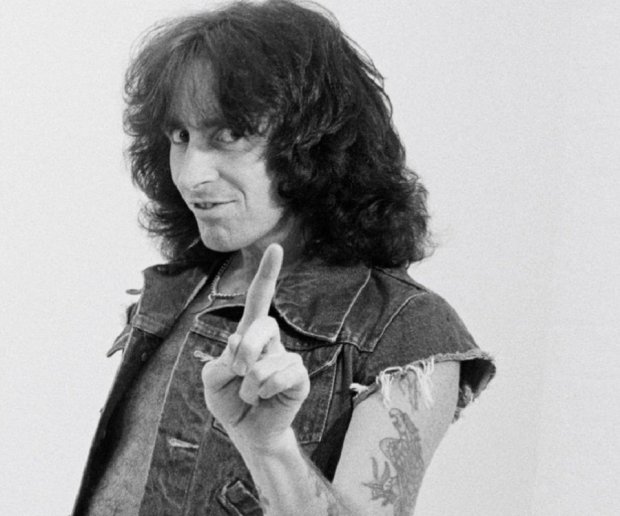
AC/DC singer Bon Scott in 1979. Image courtesy Fin Costello/Redferns
While AC/DC was able to cross over (and stay there) by the late 1970s, the list of Australians to make a splash in the USA that decade is as short as it is dire: Helen Reddy, Olivia and the brothers Gibb. Were these really the ambassadors of Aussie music overseas, especially when there was so much good happening here?
In the following years, the dream seemed to die. The Bee Gees shattered records with their contributions to Saturday Night Fever, ONJ scaled Mount Celebrity with Grease; both acts were on the nose by the early 80s. AC/DC frontman Bon Scott, the most charismatic Australia had yet produced, didn’t even make it that far. In 1979, just as the band’s Highway to Hell was finally breaking through, he died alone in his car, in excess.
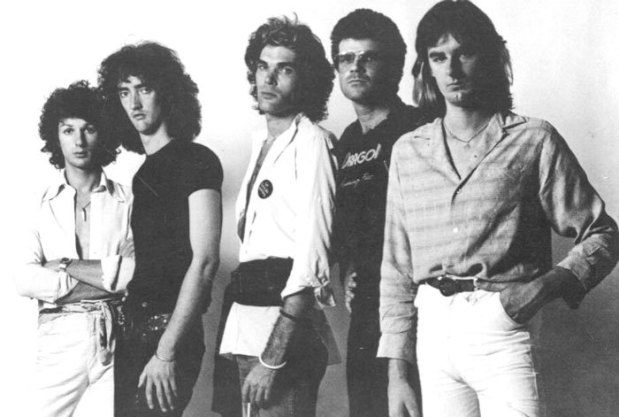
Dragon in 1977. Image courtesy audioculture.co.nz
Bands used these cautionary tales as incentives to work harder and aim higher, but none quite topped the bill. Among those who came close were Dragon, a bunch of Kiwis who had the charisma and the attitude to make it, but none of the self-control. A disastrous 1978 tour of the USA, intended to break them, did just that, but not in the way they were hoping. When you learn what it eventually took to top the US charts, it’s clear how painfully close Dragon came.
That spectacular failure and the rise of a newer, more calculated sound crossed paths in this curio from 1982:
By that time, Dragon were seen as has-beens, having had their chance and blown it. You can see it in that video, in Dragon’s lead singer Marc Hunter. He’s trying the rock star act but without any real conviction. The shades appear to be shielding him (or us) from the regret.
On the other hand, quiet 22-year-old Michael Hutchence seems self-conscious, fidgety, totally unprepared for what the next few years will bring him. Given Hutchence’s babyfaced appearance and insular behaviour, we can file Hunter’s prescient advice to him firmly under coincidence.
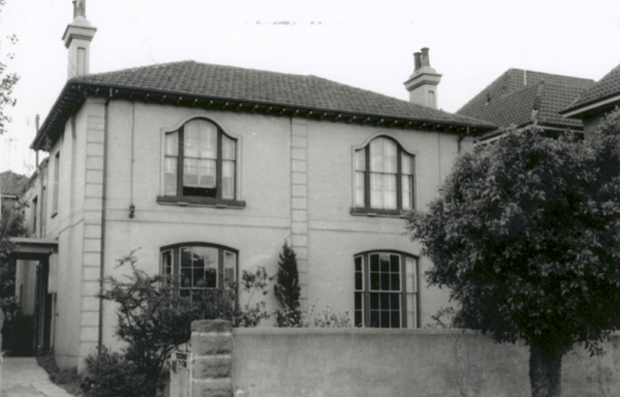
‘Heath’ in 1958. Image courtesy Woollahra Library
1991. The land at 33 Cross Street, Double Bay has been in a state of development for decades. Originally, the property had belonged to a John Gray, who in 1857 constructed his grand manor ‘Heath’ on the site. By 1934, ‘Heath’ had been converted into flats, and a bunch of other unit blocks had popped up on the site. As the 1970s rolled around, the greed that buried Juanita Nielsen came to Double Bay, looking to commercialise New South Head Road and the surrounding streets, and Cross Street was right in the crosshairs.
In 1986, while Hutchence was busy seducing the USA, ‘Heath’ and the surrounding flats were earmarked for demolition by council. Two years later, as Hutchence basked in the success of his biggest album to date, Woollahra Council approved a proposal to build a six-storey hotel complex on the site. ‘Heath’ was immediately demolished.
Being constructed in the early 90s wasn’t a pretty thing for buildings. More often than not you’d end up with spiffy new brickwork that made you look like that kid at school whose uniform hadn’t been worn in yet and looked a bit too dorkily crisp. Pretentious Roman-esque pylons, entirely too much concrete and a feeble attempt at a futuristic aesthetic intended to distance big cities from the all-too-recognisable frontages of the 1970s were common crimes among the new generation.

The Ritz-Carlton Hotel Double Bay, 1990s. Image courtesy Getty Images
And so it was for Double Bay’s new Ritz Carlton Hotel, which shortly after opening for business in December, 1991 was hired out in its entirety by then-US President George Bush for his Sydney visit. Read my lips: no vacancies.
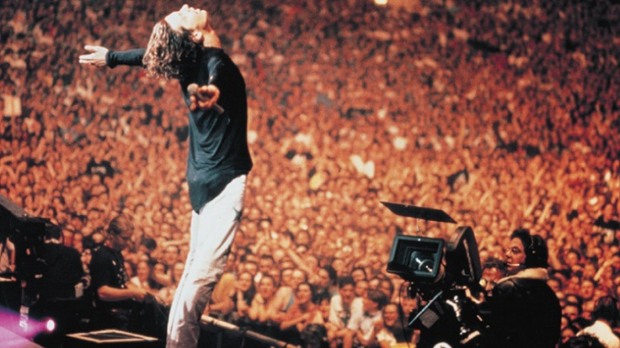
Michael Hutchence fronts INXS at Wembley Stadium, 1991. Source unknown
Meanwhile, Michael Hutchence and his backing group, INXS, are beginning their descent from the peak of global rock superstardom. Their monster single ‘Need You Tonight’ had topped the US charts in 1987, the first Australian song to do so since Men At Work’s ubiquitous ‘Down Under’ in 1983. There wouldn’t be another until Savage Garden’s ‘Truly Madly Deeply’ in 1998, by which time we’d apparently settled on lame MOR AOR music as our primary export. And Hutchence…
Well, we’re getting ahead of ourselves.
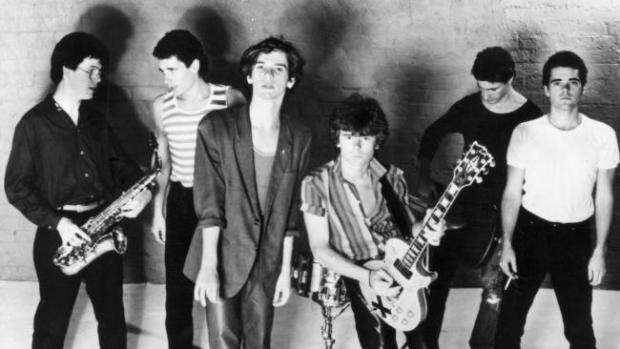
INXS, 1981. Image courtesy News Corp
INXS had emerged from the same pub scene that had bred Cold Chisel, Australian Crawl and the Angels, all of whom had tried and failed to make it in America. But where those bands had brandished an idiosyncratic, very Australian sound which made for hard listening overseas, INXS drifted away from their earlier, quirkier hits and rough image towards something a lot more contrived.
Apparently overnight and entirely coincidental to the band’s quest for fame, Hutchence transformed from the shy boy in the above video into a feline rock god who seemed to effortlessly channel Jim Morrison. It was as if he had altered himself entirely on the whim of the band, which then found itself struggling to back him up.
Questionable visual appeal of the other band members notwithstanding, Hutchence’s image and the cool, slick grooves the band laid down provided the perfect package for American audiences who didn’t even know they wanted it. In a time of hair metal and butt rock, Hutchence provided Americans with a throwback to an era where rock and roll legends were born. Whether this was intentional on his part is unclear.
I’m sorry, but when you go back and listen now, INXS’s 80s hits are indeed all style and no substance. They’re like animated gifs in music form: just one groove or riff repeated for an often obnoxious five minutes. Hutchence’s sexually charged delivery and very slick production values go a long way towards elevating them beyond sounding dated. At least, they did for a while; sadly, anything from 1990’s X album onwards sounds painfully of its time.
There’s certainly nothing particularly Australian about INXS either. At a glance, they could be American (or at least Canadian). This factor made them a target in the eyes of the Australian media of the day. Hutcho’s profile increased with each supermodel he dated, each paparazzi he punched out, and the media were there to hound him every step of the way.
In retrospect, it’s hard to imagine why he was such a drawcard for the tabloids. Perhaps his sudden rise and boring fall coincided with a boom in Australian tabloid media, which in the early 90s was caught somewhere between American sleaze journalism and hardcore British pap-rags. Maybe he was just more interesting than John Farnham or Daryl Braithwaite. Hard to believe, I know.
Speaking of celebrities, the Ritz-Carlton was, by coincidence, also proving to be a breadwinner for the Sydney paparazzi. Madonna rented several rooms in 1993 (hope they washed them afterwards), and larrikin former PM Bob Hawke married his scandalous amour/biographer Blanche d’Alpuget in front of 150 guests there in 1995 (REALLY hope they washed those rooms afterwards).
But what the Ritz-Carlton didn’t want you to know, with all their boasting of celebrity clients, was that even early on, financial struggles had accepted a permanent residency. An October 1992 report revealed an average occupancy rate of just 37%. Remember that number.
That was also the year that marked the full tilt slide in popularity for INXS. That year’s album Welcome to Wherever You Are had tanked; the accompanying Sega Mega CD ‘Make My Video’ title was beneath the treads. The band, unable to capture their Kick-era glory, were floundering. Hutchence in particular seemed wounded by the fall, with a strange event in August of that year exacerbating things.
During a night on the town in Denmark with his girlfriend, model Helena Christensen, Hutchence had become involved in an altercation with a taxi driver. Punches were thrown, and Hutchence hit his head on the pavement, fracturing his skull. He lost his sense of taste and smell, and became, in the words of INXS bassist Garry Gary Beers, “a dick”.
While Madonna was justifying her love in the Ritz-Carlton in 1993, the band released yet another “comeback album”, Full Moon, Dirty Hearts, the occupancy rate of which would have made the Ritz-Carlton proud. Production of this album was troubled, with the band finding itself at odds with an increasingly volatile Hutchence, who had become prone to violent mood swings and outbursts.
INXS laid low for several years, perhaps sensing its ever-increasing irrelevancy. But despite the lack of success, Hutchence still found himself a tabloid target. Maybe the back-to-back unsuccessful albums were intentional; a misguided attempt to dissuade the paps. Even if so, he didn’t do himself any favours when he shacked up with UK media identity Paula Yates.
Yates was the wife of Live Aid mastermind/Boomtown Rat Bob Geldof, but in 1995, ‘Do They Know It’s Christmas’ was a decade old. For Paula, it was time to trade up. In 1996, she became pregnant with Hutchence’s child and divorced Geldof, sending tabloid media into a foaming frenzy. I’d just like to ask, even with the benefit of hindsight: who really cared?
Meanwhile, the Ritz-Carlton was in the spotlight again, also thanks to a high-profile British divorce. No less than Princess Di occupied the Presidential suite in 1996 following her divorce from Prince Charles. Can I stop right here and ask why an Australian hotel needed a Presidential suite? Why can’t high rollers choose to stay in the Prime Ministerial suite?
Hotels are dehumanising places. Underneath the colours, they’re fake, temporary shelters; a place where you can be someone else and leave yourself at your real home. A place where people treat you like royalty because of how much you spend rather than who you are. You’re never truly yourself in a hotel, you’re just waiting for your next role.
Princess Di would have known it as she pondered what to do with her life following the most scandalous royal decision since the abdication.
President Bush would have known it, as he assessed his plummeting opinion polls and an all but guaranteed loss to a newcomer Southern Democrat.
Bob and Blanche would have known it as they faced a future viewed not as former PM and author, but as adulterer and home wrecker.
Madonna…no, that’s too easy.
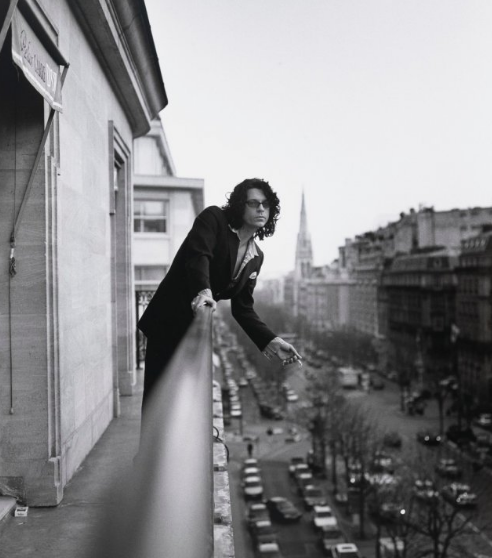
Michael Hutchence, 1997. Image courtesy Harry Borden, National Portrait Gallery
And so too would 37-year-old Michael Hutchence have known that gloomy feeling of dissociation and temporary anonymity as he checked into the Ritz-Carlton in November 1997 under his nom de plume. “Mr. Rivers” headed up to room 524, dumped his stuff, pocketed a few fancy soaps (probably), and headed out to rehearsal with INXS.
That evening, he had dinner with his father at Flavour of India at Edgecliff, where he spoke positively about the future, particularly about the prospect of spending Christmas with Yates, their daughter, and her three other kids.
When Hutchence returned to his room, he found himself despondent. He called some friends up to chat and get high, but they didn’t stay the night. Left to his own devices, his personal life imploded, and the tide went out for Mr. Rivers.
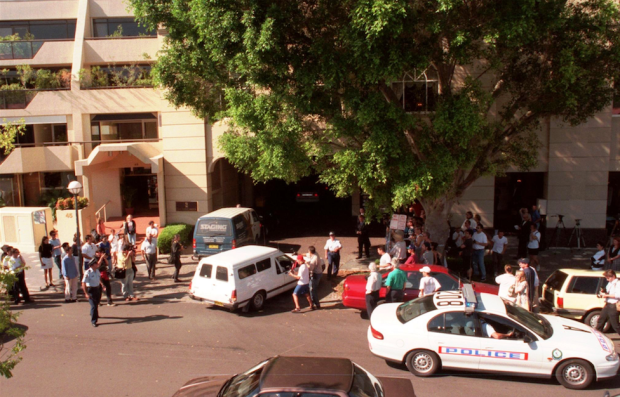
Police and the coroner attend the Ritz-Carlton, November 22, 1997. Image courtesy AP
Is it coincidence that Hutchence’s final cry for help should place him in the pantheon of tragic rock star deaths, despite his intentions?
Is it coincidence that on the site of a manor named ‘Heath’, a drug-addled, troubled Australian should die alone in his room while riding a wave of international success?
Is it coincidence that in the years after the fates of Hutchence and the Ritz-Carlton became intertwined, both the hotel and Hutchence’s band changed frontmen several times in vain attempts to recapture their former glory?
Where American hotels that play host to scandalous deaths, like the Chateau Marmot, revel in the sordid fame for years to come, the Ritz-Carlton took the very Australian route of distancing itself from the tragedy. For the next three years, there was no tribute, no signifier of what had occurred there. By refusing to capitalise on the by-association fame Hutchence had bequeathed it, the Ritz-Carlton had relegated his rock-star death to the realm of coincidence. ‘He would have died anyway, it just happened to be at a hotel,’ it seemed to say.
In 2000, the hotel itself experienced that feeling of dissociation when it changed hands and was renamed the Sir Stamford Hotel Double Bay. The Stamford Hotels and Resorts group was formed in Singapore in 1995, and named after the city’s founder Sir Stamford Raffles. I get what they were going for, but which fun-hating devils among us wouldn’t want to stay at the Raffles Hotel?
Here’s where things get a little…strange.
The Sir Stamford closed in 2009, with plans in place to demolish the hotel and replace it with 14-storey twin-tower apartments, presumably to keep Double Bay looking like the rest of Sydney. But Woollahra Council, bless ‘em, dared to be different and refused to listen like thieves, canning the proposal and leaving the Ritz-Stamford – and the once-prestigious Double Bay – to sink into destitution.
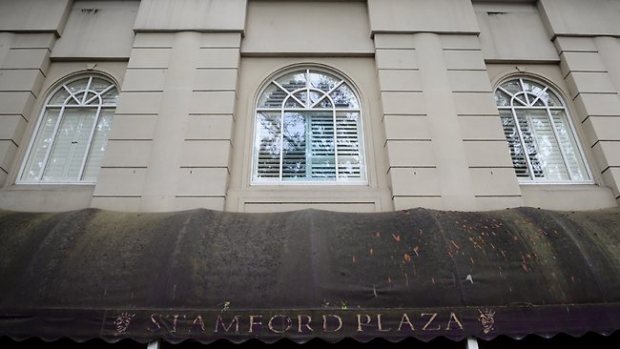
The decrepit Stamford Plaza, 2012. Image courtesy Daily Telegraph
Illegal parties, prostitution rackets and Russian cabaret dinners all allegedly took place in the husk of the hotel for four long years, dragging down the reputation of the area just as Bondi Westfield dragged out all its money. For the blue bloods who believed Double Bay was still the beacon of avarice it had been in years past (as if that was something to be proud of), this came as a shock.
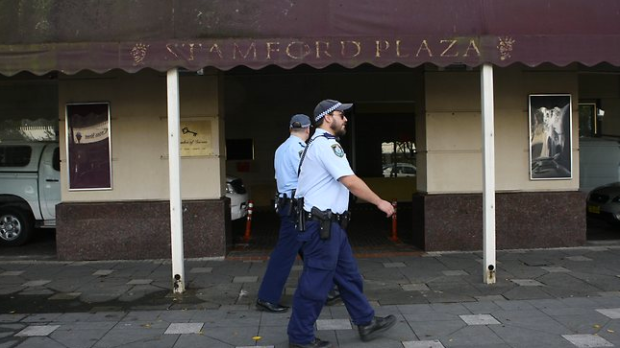
Police patrol the abandoned Stamford, 2012. Image courtesy Courier Mail
Now, when I was a kid, Double Bay had the dubious honour of being known simultaneously as “a really rich area” and “a place where smackheads steal VCRs”. Even with my mind conjuring up visions of the Foot Clan emptying delivery vans along New South Head Road, it was cemented for me as a place not to go. Rich people were trouble, “smackheads” sounded like trouble (no kid likes getting a smack, and especially not in the head), and the shops were all boring.
It’s amazing to me that in just 12 short years, Double Bay had gone from being a slam-dunk venue for a world-class luxury hotel to an absolute bomb site. Coincidence, then, that Michael Hutchence’s death had been the match that started the fire? Or maybe it had been destined to fall this far all along. Elegantly wasted, indeed.
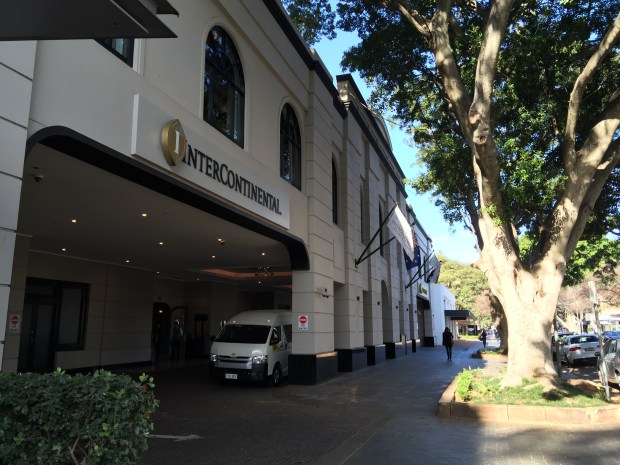
InterContinental Double Bay, 2016.
In 2013, some extremely optimistic investors saved 33 Cross from the swing of the wrecking ball, and today, it operates as the InterContinental Double Bay, in the same building that played host to presidents, rock stars, Russian hooker parties, and all that other shabooh shoobah.

InterContinental Double Bay, 2016.
It wasn’t enough for me just to take some dodgy photos of the extremely difficult-to-shoot frontage; I had to get inside, and short of specifically asking for room 524 (let’s leave that kind of thing to the experts), I explored.
The chap at the front desk instantly denied any knowledge of anything that had remotely occurred on the premises prior to the moment I’d addressed him. In fact, he seemed almost terrified that one of the great unwashed had found their way in. Poor guy. They must have had a lot of stickybeaks coming in to see where it happened, so it must be in their training to deny everything.
Inside, the hotel looks quite vintage, so when I informed him that I was a guest, that I’d stayed there as a kid and wanted to know more about what the hotel was like then, he was much more forthcoming. He seemed quite proud of the place, despite only being the front desk guy – the finest loyalty money can buy. When he finished his spiel I turned to leave, anxious to go and take pics while I had this guy’s tacit approval. He called out after me, “Hey, what was your name, sir?”
“Murray Rivers.”
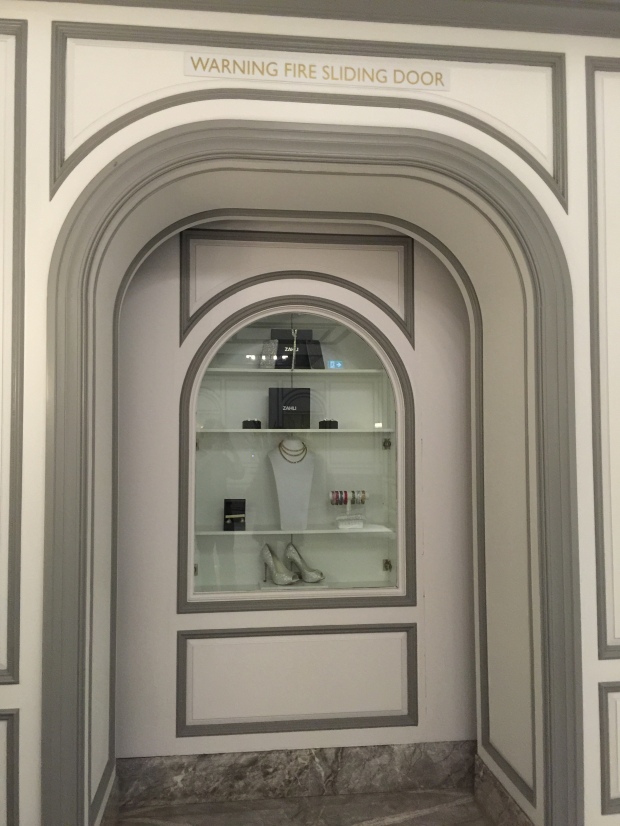
The renovation work at the Intercontinental was pretty shoddy: most of the place was plastered up and looked quite tacky. I was convinced there had to be some evidence of the past here somewhere. You couldn’t go this long stagnating under the guise of “closed for renovations” and cover everything up. I was sure they would have changed the room numbers to confuse would-be trophy hunters, but there had to be something.
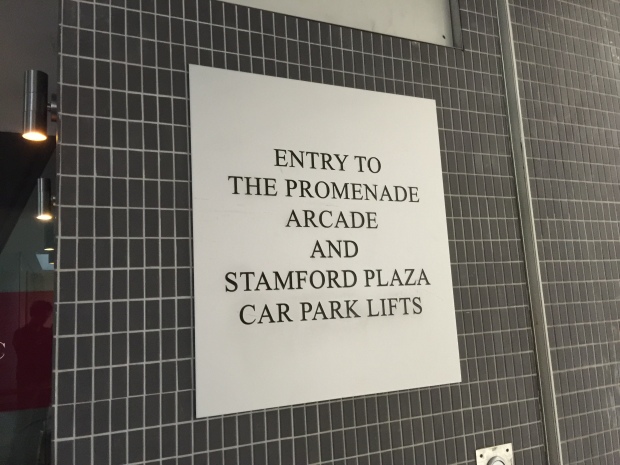
I found it in the retail warrens that criss-cross beneath the hotel proper. It’s not much, but it’s all you’re getting.
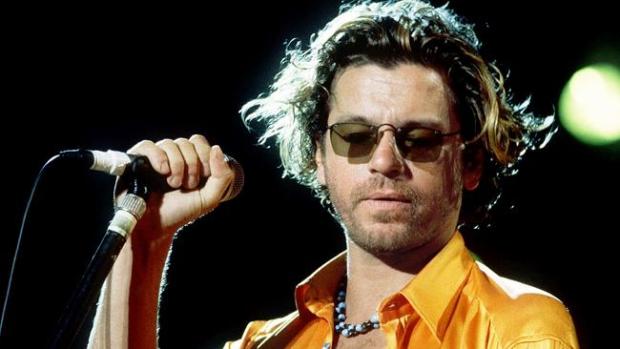
Michael Hutchence, 1994. Image courtesy AP Photo
A country with a bad case of identity crisis, Australia backed its boy when he was on top of the American world, stuck the knife in when he wasn’t, and all but forgot about him once he fell on it. By Michael Hutchence, the coincidental rock star, the promise of Johnny O’Keefe was fulfilled. Ever since his death, once an Australian hits the top, they know where they’ll end up: falling down the mountain, end up kissing dirt.
Lifeline 24 hour crisis support number – 13 11 14








